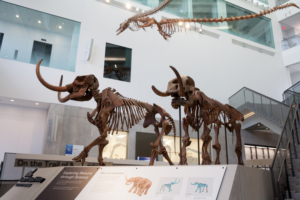U-M Museum of Natural History Opens Next Phase with Major Exhibits, Hands-On Labs

The University of Michigan Museum of Natural History announced today it will open the second half of the museum, adding new exhibits and labs for visitors on Sunday, Nov. 10.
The museum, part of U-M's College of Literature, Science, and the Arts, unveiled its new home inside the new $261 million, 312,000-square-foot Biological Sciences Building last April after calling the Ruthven Building home since 1928.
In November, the museum adds even more to explore with three new exhibits: an interactive journey through life's building blocks as seen in "Under the Microscope," including a giant, walk-in model of a cell; the "Exploring Michigan" gallery highlighting our state's natural history with life-size dioramas and hands-on activities; and "People and the Planet," an in-depth look at how the natural world has shaped human culture and how humans impact our natural world. Research Stations throughout the museum will offer a look into the latest findings from U-M scientists.
In two new public Investigate Labs, visitors will take an active role in scientific inquiry. In the Nature lab, guests will explore various natural phenomena and examine parts of our collection in close detail to learn about the natural world. In the Micro Worlds lab, visitors will use microscopes and other tools to examine parts of our world that are too small to see with the naked eye. In both labs, participants will learn about historical breakthroughs and contemporary discoveries in research.
These brand new exhibits join the museum's iconic mastodon couple, prehistoric whale skeletons and touchable T. rex skull, along with its comprehensive evolution exhibit spanning four billion years of life on Earth.
Now embedded in a state-of-the-art research facility, the museum invites visitors to learn and explore about the past while discovering the present. New features already introduced include a 25-foot Quetzalcoatlus pterosaur soaring high in a five-story atrium; a high-tech Planetarium & Dome Theater; an interactive, multimedia Tree of Life display that illustrates how all living things are connected; a Fossil Prep Lab, where visitors can observe fossils being readied for study and display; and the Student Showcase, which features research projects from U-M undergraduate students across disciplines.
"It's been so exciting to share our new home, galleries and programming with the community," said Amy Harris, director of the museum. "Now we can't wait for visitors to experience the rest of what we have in store. These hands-on labs and exhibits are unlike anything the museum has been able to offer before, but we've also stayed true to our roots, highlighting our state's own rich natural history."
The museum will be closed to the public Saturday, Nov. 9, for a private preview event for members and donors. A U-M student event will be held Friday, Nov. 15.
The Museum of Natural History's origins date back to the university's first natural history collections, which were founded in 1837. U-M's collections have been on public display since 1841.
The U-M Museum of Natural History has welcomed more than 100,000 visitors since it reopened in April. The museum is free for individuals and families. It is located at 1105 N. University Ave., Ann Arbor.
Photo by Michelle Andonian
Comments

Videos


